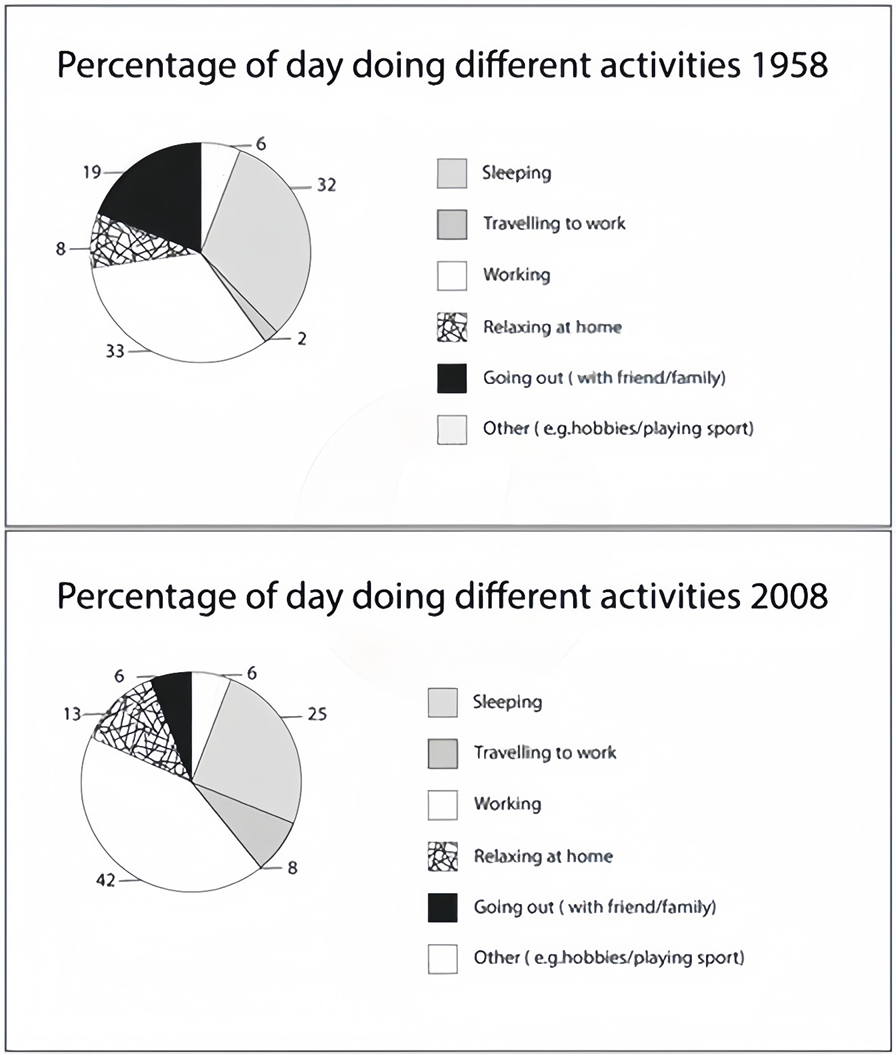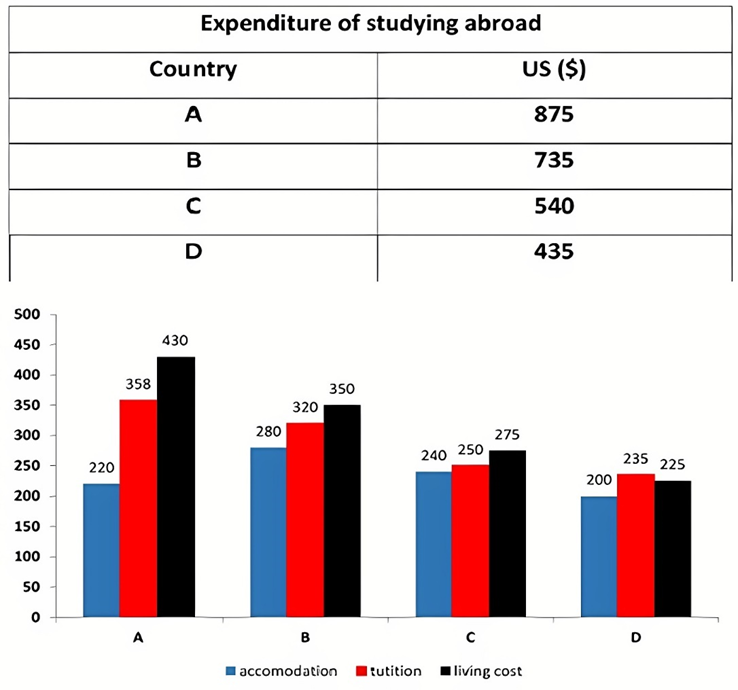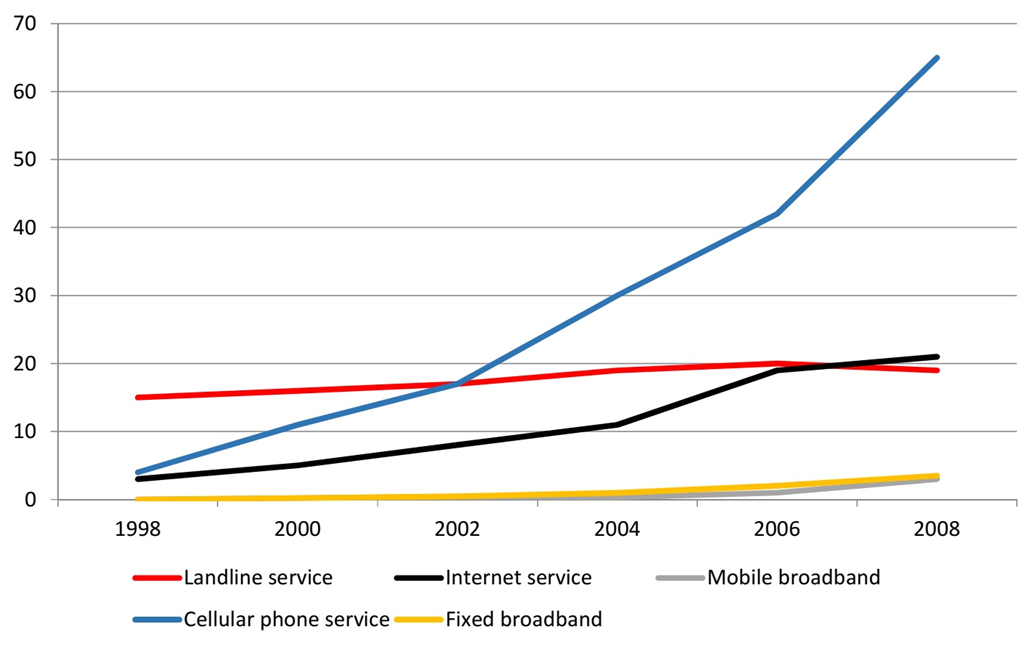The charts below show the percentage of time working adults spent on different activities in a particular country in 1958 and 2008.
Summarise the information by selecting and reporting the main features, and make comparisons where relevant. Write at least 150 words.
The charts below show the percentage of time working adults spent on different activities in a particular country in 1958 and 2008.
Summarise the information by selecting and reporting the main features, and make comparisons where relevant. Write at least 150 words.
Quảng cáo
Trả lời:

Sample 1:
The pie charts illustrate the average percentage of an employed person’s day spent doing different activities in 1958 and 2008, in a particular country.
Overall, employed people in this particular country spent the most amount of time in a day, in both 1958 and 2008, at work. Furthermore, there was an inverse relationship between working and sleeping over the 50 years.
In 1958, working people in this country spent one-third of their day at work, followed by just under one-third of their day sleeping. Going out with friends or family took up the next largest portion of time in a day, at 19%. Meanwhile, travelling to work was the activity that took up the least percentage of time in someone’s day.
Fifty years later, the percentage of a day that people spent at work increased to 42%, while the figure for sleeping had dropped to 25%. Less time was spent going out with family and friends (6%), but more time was allocated to relaxing at home (13%). In addition, the figure for the portion of the day that people spent travelling to work quadrupled to 8% over the period.
Sample 2:
The pie charts illustrate the percentage of time adults waste during their working day on various tasks in a particular nation between 1958 and 2008.
Overall, the percentage of time spent working and sleeping was the highest in 1958. Additionally, while the time spent on every other activity increased, the percentage spent going out and sleeping declined.
According to the first chart, the percentage of time spent on working and sleeping was similarly the highest, at 33% and 32%, respectively. Going out accounted for 19%, while relaxing at home was 11% less. Furthermore, the total percentage of time spent on other activities, such as playing sports (6%) and traveling to work (2%), was equal to the percentage of time spent relaxing at home (8%).
In the second chart, the working percentage increased significantly to 40%. Meanwhile, the percentage of time spent sleeping decreased by 7%. Moreover, the percentage spent relaxing at home was 5% larger in 2008. The percentage of time spent on other activities was identical to time spent on going out with friends, at 6%. Finally, the time spent travelling to work increased to 8% in 2008.
Sample 3:
The provided pie charts outline the average time distribution of an employed individual to daily activities in a specific country during 1958 and 2008.
Overall, work and sleep constituted the most significant portions of a working adult’s time in both 1958 and 2008. While the percentages allocated for traveling to work, working and relaxing at home ascended, the time spent socializing and sleeping experienced a decline.
In 1958, approximately one-third of the day was devoted to work (33%), followed by an almost similar duration spent on sleep (32%). Going out with friends or family accounted for 19% of their daily routine. Meanwhile, commuting to work and relaxing at home occupied smaller segments, comprising only 2% and 8%, and the residual 6% was attributed to other activities such as hobbies or sports.
From that time to 2008, the proportion of time dedicated to work significantly increased to 42%. Simultaneously, the duration allocated for relaxation at home saw a notable rise, representing 13% of the day, and the time spent commuting also quadrupled to 8%. Conversely, the time distribution for sleep diminished to 25%, while socializing with family and friends also reduced to 6%. The sole category which stayed unaltered was others, at 6%.
Sample 4:
The pie charts illustrate changes in the proportion of time that working adults spent on different activities in 1958 and 2008.
It is clear that in both years, working accounted for the largest percentage of time, while the surveyed people spent the least proportion of time on commuting. Also, the figure for going out witnessed the most dramatic change.
Looking at the information in more detail, we can see that in the initial year, 33% of the time was allocated to working, closely followed by the figure for sleeping (32%). By contrast, people only spent 2% of their time on commuting. Going out took up 19% of a day, and this figure was more than twice the figure for relaxing at home. The proportion of time distributed to other activities such as hobbies and playing sports was 6%.
In the year 2008, the proportion of time people spent on working and relaxing at home saw a remarkable rise to 42% and 13% respectively. The most drastic change could be found in the time allocated for commuting, with the figure growing by 4-fold. By contrast, there was a sharp decline in the percentage of time distributed to going out and sleeping by 13% and 7%. In this year, people still spent 6% of their time on other activities.
Sample 5:
The provided charts illustrate the percentage of the day working from those who were experiencing adulthood, in terms of activities in 1958 and 50 years later.
Taken as a whole, a brief assessment of the information reveals that the working adults relied on almost all their time for work. The time dependent on working and sleeping has an inverse bond over 50 years.
To begin with, in 1958, workers spent roughly 1/3 of their days at work and less than 1/3 of their days sleeping. After that, outdoor activities with friends and family accounted for 19%. Additionally, spending time reaching the workplace had the lowest percentage of traveling to work at 2%.
Besides, in 2008, the statistics of working days witnessed a significant increase. This figure rose to 42%, and the sleeping days, in contrast, declined to 25%. Furthermore, the percentage of commuting days experienced had increased four times to 8%.
Hot: 1000+ Đề thi cuối kì 1 file word cấu trúc mới 2025 Toán, Văn, Anh... lớp 1-12 (chỉ từ 60k). Tải ngay
CÂU HỎI HOT CÙNG CHỦ ĐỀ
Lời giải

Sample 1:
The bar graph illustrates the overseas students' spending on accommodation, tuition, and living expenses, while the table depicts information about the average weekly expenses by international students in four countries: A, B, C, and D.
Overall, foreign students need to spend the highest in country A and the lowest in D. In nearly every nation, the international students’ weekly average living expenses are the greatest, while their housing cost registers the lowest.
The costliest country for studying is A, with a weekly average expense of 875 dollars. This is followed by B, C, and D, which have weekly expenses of 735, 540, and 435 dollars, respectively. However, foreign students always pay the least for accommodation, which incurs on average weekly 220, 280, 240, and 200 dollars in the nations A, B, C, and D, respectively.
On the other hand, living expenditures account for the highest portion of average weekly costs for international students in countries A, B, and C, with 430, 350, and 275 dollars, correspondingly. Tuition fees in the same countries (A, B and C) come in second with the weekly averages of 358, 320, and 250 dollars in order. However, D is the only nation where education accounts for the highest average spending area, coming in at USD 235, followed by the cost of living (USD 225) and housing (USD 200).
Sample 2:
The table illustrates information regarding the weekly spendings by overseas students in four countries, A, B, C and D, while the bar graph depicts the students’ expenditure on the sectors, housing, education fees and living expenses.
Overall, the cost of studying abroad is the highest in country A and the lowest in D. Apart from country D, living costs account for the most part of the weekly spendings in all countries, while accommodation registers the least.
Regarding the total cost of studying, A is the most expensive country with weekly average 875 dollars, followed by B, C and D with 735, 540 and 435 dollars, respectively. On the other hand, the overseas students always spend the least on accommodation, which are on average weekly 220, 280, 240 and 200 dollars in the corresponding countries A, B, C and D.
Considering the living cost, it takes the largest share of foreign students’ average weekly expenses in countries A, B, and C with 430, 350 and 275 dollars, respectively, while tuition fees in the same countries hold the second place with weekly average 358, 320 and 250 dollars, sequentially. However, D is the only country where tuition fee occupies the highest expenditure with average weekly 235 dollars, followed by living cost (USD 225) and accommodation (USD 200.)
Sample 3:
The table and bar graph depict information regarding the weekly spendings by overseas students in countries A, B C and D.
Overall, there are three elements, housing, school fees and living costs that contribute to the total weekly spendings. The total expenditure in country A is the highest while it is the lowest in country D. Living costs account for the most part of the weekly spendings in all countries except D.
The total mean weekly cost for pupils to study in country A is US$875, next by country B at US$735, and then by country C at US$540, and finally by country D at US$435. The living costs are always the biggest component of the expenditure except for country D, with about US$10 less than the major spending which is the school fees.
Accommodation accounts for the least among all spendings in all countries. The most expensive housing is found in country B, at US$280, and the cheapest in country D at US$200. The middle range can be seen in country A at US$220 and country C at US$240, respectively. Costs of the tuition fee range between US$ 358 and US$235 in country A and D, in order.
Lời giải

Sample 1:
The line graph gives data about the number of users of five different communication services worldwide from 1998 to 2008.
Overall, all services experienced some growth over the 10-year period, with cell phone and Internet services experiencing the most growth and becoming the most popular forms of communication.
In 1998, the figures for cell phone and Internet users started at around 5% of the population. They both increased over the remaining years, with cell phone service gaining the highest position in 2008, with more than 60% percent of the population using this type of service. This number was approximately three times as much as that of Internet service in the same year.
Meanwhile, throughout the 10-year period, little change was seen in the use of landline services, at about 15% of the population. Also, the use of mobile and fixed broadband services was minimal before 2002. The figures for these two services rose slightly to roughly 5% of the population by the last year.
Sample 2:
The line graph gives data about the number of users of 5 different communication services worldwide from 1998 to 2008.
Overall, cell phone and Internet services became more and more popular, and others similarly experienced minimal growth over the years.
In 1998, the figures for cell phone and Internet users started at around 5 per 100 inhabitants. They both increased over the remaining years, with cell phone service gaining the higher position in 2008, at more than 60 users per 100 in habitants. This number was approximately three times as much as that of Internet service in the same year.
Meanwhile, throughout this 10-year period, little change was seen in the use of the landline service, with about 15 users per 100 inhabitants. Also, mobile and fixed broadband had yet to be introduced by 2002. The figures for these two services rose slightly to roughly 5 users per 100 inhabitants in the last year.
Sample 3:
The line graph illustrates the number of people in the world who used five categories of communication services at two-year intervals from 1998 to 2008.
Overall, although all kinds of communication services tended to grow during the entire time period, only the increase in popularity in cellular phone service was significantly higher than the rise in that of other means of communication.
In 1998, the figure for cellular phone service was round about 500 people, as same as Internet service’s. From 1998, the number of individuals using cellular phone services increased dramatically to exactly 6000 people and became the most common means of communication in the year 2008. Additionally, the figure for Internet service was about five times higher than during the period of 10 years.
With 1500 people used, the figure for landline service was the highest number in 1998. However, that figure had a minor increase to 2000 people in 2006 before it dropped slightly to approximately 1800 people in 2008. The figure for mobile broadband and fixed broadband remained nearly 0 throughout the first six-year period. They were also the least popular kinds of communication services despite rising up to 500 people in 2008.
Lời giải
Bạn cần đăng ký gói VIP ( giá chỉ từ 199K ) để làm bài, xem đáp án và lời giải chi tiết không giới hạn.
Lời giải
Bạn cần đăng ký gói VIP ( giá chỉ từ 199K ) để làm bài, xem đáp án và lời giải chi tiết không giới hạn.
Lời giải
Bạn cần đăng ký gói VIP ( giá chỉ từ 199K ) để làm bài, xem đáp án và lời giải chi tiết không giới hạn.
Lời giải
Bạn cần đăng ký gói VIP ( giá chỉ từ 199K ) để làm bài, xem đáp án và lời giải chi tiết không giới hạn.
Lời giải
Bạn cần đăng ký gói VIP ( giá chỉ từ 199K ) để làm bài, xem đáp án và lời giải chi tiết không giới hạn.